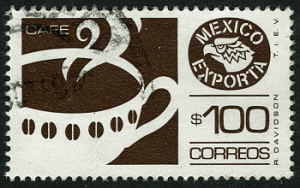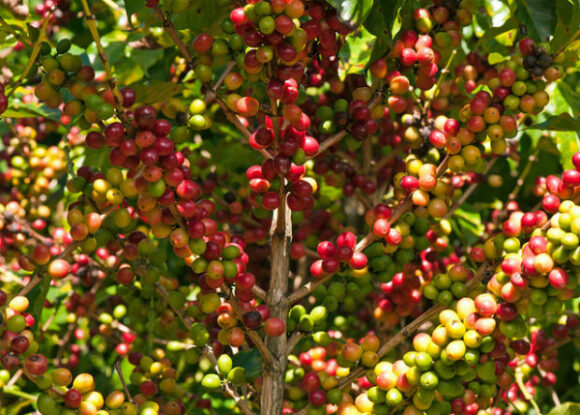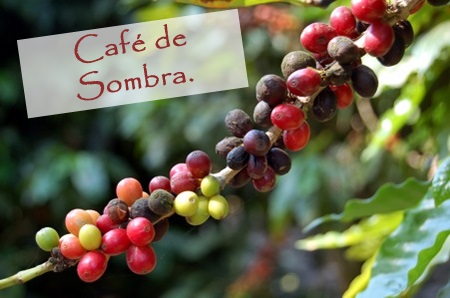Mexico is the world’s ninth largest coffee producer and second largest producer of organic coffee. However, coffee production in Mexico in recent years has been affected by adverse weather conditions (untimely rainfall, frosts, excess humidity) which have been ideal for the expansion of coffee rust disease (roya del café) in many production areas. The 2015/16 coffee production forecast is for 3.3 million 60/kg bags (sacks), the same as the 2014-15 total production, and much lower than historical production outputs of around 5 million bags.
About 35% of Mexico’s coffee production area is located at elevations of 900 meters or higher above sea level; another 43.5% grows between 600 and 900 meters. Coffee grown at the higher elevations is generally higher quality than that grown at lower elevations.
Mexico has about 500,000 coffee farmers, looking after 600,000 hectares of coffee trees in twelve states. Plantations in the states of Chiapas, Veracruz, Guerrero, Oaxaca, and Puebla account for about 93% of total production. Almost all coffee-growing areas have been affected by outbreaks of coffee rust. The most affected states are Veracruz, with about 70% of the area affected, and Chiapas with about 60% of the area affected. About 40% of the coffee planted area nationwide has been affected somewhat by coffee rust.
Coffee rust is a fungal disease that can cause plant defoliation. In moderate cases, leaf defoliation reduces plants’ ability to produce fruit (the seeds of which are the actual coffee bean). In serious cases, the trees will die. The rust has spread northward from Central America, and reached Chiapas 4-5 years ago.
The Agriculture Secretariat (SAGARPA) has responded by installing about 35 nurseries in states most affected, growing coffee plant varieties resistant to rust. But these trees will need about 4 years to come into production so government officials do not expect coffee production to rebound until 2019. Sagarpa’s objective is to renew at least 250,000 hectares before the end of this administration’s term in 2018.
The SAGARPA program, aiming to increase coffee production and productivity, includes US$83 per producer as incentive, technical assistance packages of up to $140 dollars per hectare, and 500 coffee plants to renovate coffee plantations, as 80% of plants are old and less productive and often rust-prone.
However, coffee organizations complain that resources are not reaching the affected areas fast enough and that program implementation has been too localized instead of having a nation-wide strategy.
Some state governments and international companies are offering support for various types of price-enhancing certifications such as organic, Fair Trade etc. Some indigenous communities are planting their coffee trees among other trees like lime and avocado to diversify production and provide shade that helps coffee quality and enhances eligibility for value-added certifications like Rainforest Alliance and Shade Grown.
As production techniques continue to evolve, some producers have increased plant density from 2600 plants per hectare to 5000 plants per hectare.
Recent figures suggest that about 96% of Mexico’s coffee is of the Arabica variety. The remaining 3-4% is the Robusta variety, used in the production of instant coffee. Mexico is importing large quantities of Robusta variety coffee beans as the large Nestle plant in the city of Toluca has been increasing its output of instant (soluble) coffee. However, Nestle has also increased the use of Arabica coffee in its products. SAGARPA is now supporting the planting of Robusta coffee to decrease coffee bean imports and to support Mexico’s goal of becoming a major producer of soluble coffee.
Mexico is also producing excellent organic coffee, a trend which is increasing among producers. However, coffee rust has hit areas of organic coffee more than conventional plantings. According to SAGARPA, about 7 to 8% of growers are cultivating organic coffee, mainly for export.
About 40% of Mexican coffee production is marketed for local consumption, according to AMECAFE, and the remaining 60% is for export. The USA continues to be the main international market for Mexican green coffee beans.
Domestic consumption
Coffee consumption in Mexico has been increasing, with estimates of up to 2.6 million 60 kg. bags total usage this year, and consumption (of roasted and soluble coffee) at between 1.3 and 1.5 kg/person.
The importation of coffee is expected to rise in 2016, in order to meet domestic demand.
Increased consumption has been driven by government and retail advertising and by the growing number of specialty coffee shops in Mexico. (Starbucks alone has opened 500 coffee shops in Mexico). Soluble coffee still makes up about 68% of domestic consumption but ground coffee consumption is increasing among the middle class, whilst high-income consumers often want fashionable value-added imported coffee.
Related posts



